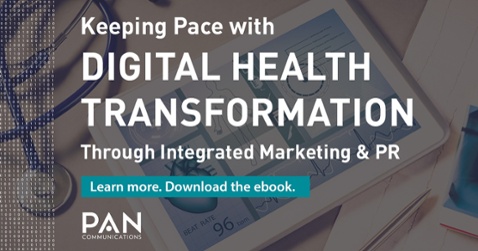How content with a focus on experiences and emotional marketing can keep customers connected and create advocates for your brand.
Today’s healthcare landscape is rapidly changing. Factors such as wavering legislation, value-based care’s impact on the physician model, pressure on pharmaceutical companies to reduce costs, the introduction of wearables to the market and informed consumers are contributing to this evolution. At the same time, audiences—plans, providers, employers, patients—are also changing the way in which they seek information. According to DMN3, 72 percent of Internet users say they searched online for health information within the past year. But the same message is not always appropriate for each of these diversified audiences.
So, what does this constant evolution mean for your healthcare brand, and how can you effectively utilize all that is available for today’s marketers to connect with your target audience and grow brand awareness? Employing a strong integrated marketing and PR strategy can be a key move to reach that next step. We distill three pillars inside that strategy—storytelling, brand advocacy, emotional marketing — that, when combined, will help you take the content approach for your healthcare brand to the next level in the age of the connected customer.
Storytelling
Storytelling has become a buzzword in recent years, but stories are still the best way to create stronger connections with key constituents, be they patients, providers, health plans, policymakers or other influencers. Yet, the question many healthcare companies and organizations continue to struggle with is: how do we use stories to create and nurture customer relationships?
The answer is very simple in theory: personalized storytelling. It comes down to listening, learning and engaging with your customers. Take out assumptions and lead your audience along a journey without selling or pushing them. Staying genuine and authentic will increase brand awareness, return higher engagement rates and, ultimately, convert more qualified leads.
Keeping your content honest equates to authentic storytelling. Strive to provide customers with an opportunity to feel like they are part of a larger group. Research from psychologists Roy Baumeister and Mark Leary best describes this need in their “belongingness hypothesis”: “People have a basic psychological need to feel closely connected to others, and that caring, affectionate bonds from close relationships are a major part of human behavior.”
Emotion-led marketing
Find a way to connect with your customers on a deeper, more emotional level. Do you give them peace of mind? Do you make life easier? Use these triggers to strengthen your relationship and foster loyalty. Enhanced loyalty might be the most impactful outcome of well-done storytelling, leading to more engagement with your brand.
Take, for example, a PAN client who focuses in the biopharma market, specifically the rare disease space. Rather than promote one-off campaigns they have designed and executed on behalf of pharma and biotech companies, or differentiate on the novel treatments they helped commercialize, for the past several years they’ve used Rare Disease Day to elevate their story. This places the larger focus more holistically on rare disease, making it personal by showcasing the patients and care givers who make up this unique community. Through podcasts, documentary movies, earned, owned and shared media, they have taken their audience down a path via a well-thought out and executed content strategy, one that engages the audience, solicits emotion and, in effect, connects them more closely to the brand. Given that Rare Disease Day typically falls in February, they use this milestone as a jumping-off point to set the tone of their content marketing, PR and communications strategy for the remainder of the year.
Targeting your approach
Personalized storytelling might seem particularly easy when thinking about targeting the patient in the context of a B2C approach. Think of all the relevant ways to showcase the value of benefits, cost and care efficiencies, improved care, wellness, virtual care, chronic condition management, tobacco cessation and many other highly relevant and personal topics.
It can be more challenging on the B2B side, however, when trying to sell into providers or health plans. B2B marketers are increasingly turning to Account-Based Marketing strategies to optimize this approach. ABM is based on setting goals for target accounts and communicating with prospects as a market of one. It’s a frontline approach to ensure marketing teams are speaking to individuals in the field, whether they fall in the top, middle or bottom of the sales funnel. The right positioning and personalization will help you engage your target market and move from awareness to con-sideration to intent.
An ABM strategy arms your sales team with content that is meaningful to their respective prospects. The key to ABM rests in the collaborative efforts of the sales and marketing teams. To work effectively, both sides need to be aligned and acknowledge the benefits that ABM has to offer increased ROI, higher degree of personalization, increased conversion potential, improved brand reputation and better customer relationships.
Creating brand advocates
Speaking of building better relationships, look no further than the earned-shared-owned ecosystem to understand how they magnify each other to support an advocacy program that can take your storytelling to the next level. At the end of the day, a big part of your content marketing effort is storytelling, not exclusively how you tell your story, but how those who engage with your brand, products and services tell it. Building brand advocates takes time and resources. It also takes a dedicated approach to nurturing customers’ experiences, so they become loyal and willing to testify to your company’s vision.
Just as brands build advocates in the B2C space, so too can healthcare brands in the B2B arena. Why? Because it all comes down to a few core tenets: trust, reference and reviews. If you hit on all of these critical elements, you’re on the path to building brand loyalists. The winning combination
of word-of-mouth marketing, trustworthy recommendations and online “reviews” move a healthcare brand toward higher rates of consideration; therefore, the peer testimonial holds the same weight as it does for consumer brands. The challenge is guiding their passion and honing their experience to funnel into high-quality referrals and, ultimately, drive sales.





